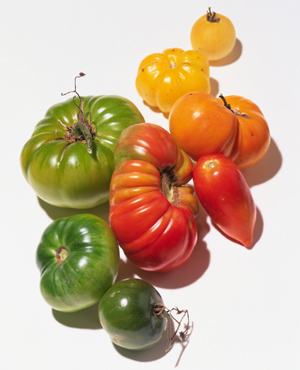Heirloom Tomatoes
Great tomato flavor that has been passed down for generations!
Unique in shape, color, size, and flavor, heirloom tomatoes are fast becoming the most popular tomatoes around. For those who appreciate a tomato in its simplest form, any of the numerous heirloom types will certainly delight the palate.

Heirloom tomatoes must be open-pollinated (not a hybrid) and are produced suing classic breeding practices. They can be grown in greenhouses in a controlled atmosphere or outside in a field. Either way, heirloom tomatoes have a taste that can be enjoyed fresh or as a recipe ingredient. Some favorite heirloom tomatoes are Black Crimson (from Russia’s Crimean Peninsula), Cherokee Purple (originally grown by the Cherokee Indian tribe in Tennessee), Brandwine (an Amish variety), and Marvel Stripe (aptly named for its radial, red striations).
Because heirlooms come in such interesting shapes, colors, and sizes, simply look for those with maximum coloring that are plump, smooth skinned, and feel heavy for their size. If the tomatoes are somewhat soft and yield to touch, then they are fully ripe, and must be used immediately. Heirlooms should not be refrigerated unless they have already been prepared, or if they are completely ripened and would otherwise spoil if left at room temperature. To store, place tomatoes stem end up in a closed paper bag, with or without an ethylene-producing fruit like a banana or apple to hasten the ripening process.
Like regular tomatoes, heirlooms are an important source of vitamins A and C. Heirloom tomatoes are also fat free and contain no cholesterol, which makes them a healthy addition to a meal. So enjoy something old and something new with heirloom tomatoes while they are available now through the end of October in your produce department.


USANA vitamins and nutritional supplements USANA Probiotic contains Bifidobacterium, BB-12® and Lactobacillus rhamnosus GG, LGG®, the strains best documented to survive transit through the harsh, acidic environment of the stomach to colonize the intestines.